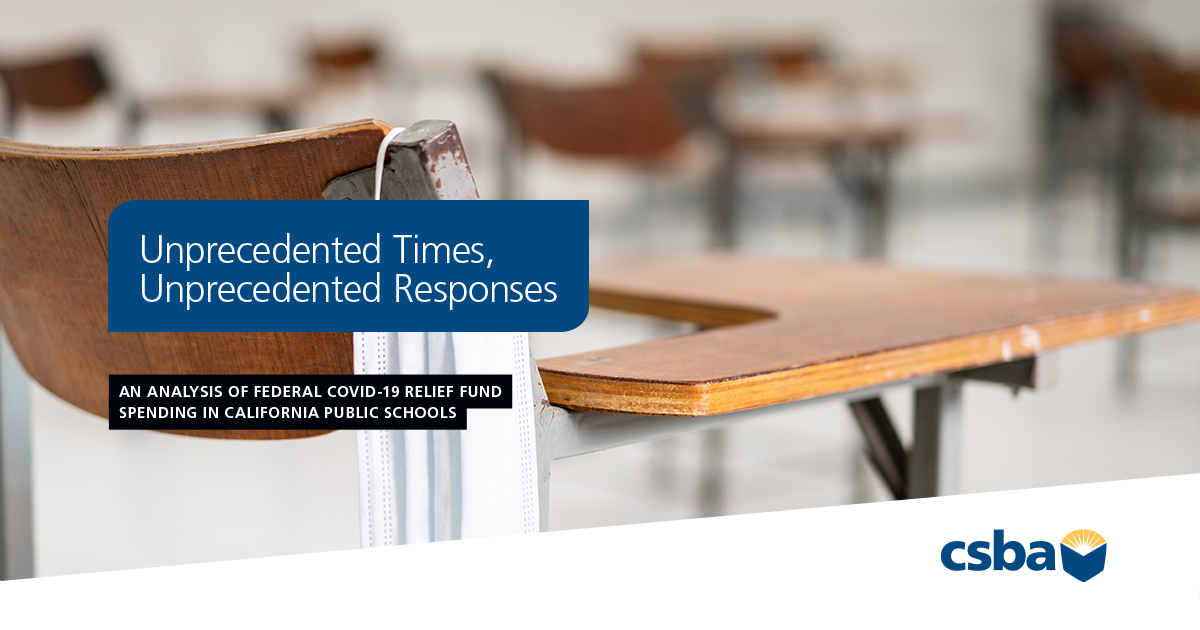By Jeremy Anderson
The first spending deadline for the historic federal COVID relief funding known as the Elementary and Secondary School Emergency Relief (ESSER I) fund and the Governors’ Emergency Education Relief (GEER I) fund was Jan. 30, 2023. These 2020 funding packages were the earliest federal relief aid issued to help local educational agencies address the challenges of the COVID-19 pandemic. CSBA has been monitoring COVID relief funding for all California school districts and county offices of education (COEs) and issued its first report on the progress of spending federal aid in June 2022. CSBA also published an update in December, reporting on the use of all ESSER and GEER funds after the deadline to reserve funds on Sept. 30, 2022.
As with previous releases, the spending data for all packages reflect what LEAs have already spent, not what they have earmarked for use. This is particularly important for ESSER II and III as LEAs still have time to spend these funds. For deeper insights into the priorities, spending strategies and implementation challenges of COVID relief funding, check out CSBA’s second report on emergency aid, which contains survey data on these topics from a representative group of 239 LEAs across the state.
What is the spending progress of school districts and COEs?
In December, CSBA reported that school districts and COEs had spent nearly all their $1.4 billion ESSER I and $338 million GEER I allocations, which expired in January 2023. Only 27 of the more than 900 LEAs had remaining funds as of September 2022. That number had dwindled to four by the spending deadline in late January, two of which reported spending over 98 percent of their allocations. Statewide, LEAs that received the first round of COVID-19 relief funding spent 99.9 percent of their allotments.
ESSER II and III saw gains in spending progress over the past quarter. ESSER II’s first set of deadlines to reserve funding is in 2024, and ESSER III’s is in 2025. School districts and COEs have spent around 77 percent of the $6 billion ESSER II fund allocation, up from 71 percent in the fall.
At $10.8 billion, ESSER III provided California a substantially larger amount of funding than its predecessors. LEAs have spent a third (31 percent) of the largest ESSER III fund. They have spent nearly a quarter (24 percent) of the set-aside portion of ESSER III meant to address the academic impact of lost instructional time.
Monitoring progress in the remaining COVID-19 relief packages will be essential as LEAs turn to them as earlier packages expire.
What spending categories are LEAs prioritizing?
LEAs report their spending using legislatively defined categories. As with other reporting periods, LEAs continue to spend significant portions of ESSER funding in broader, legislatively allowed categories such as “resources for schools” and “other activities necessary to maintain operations.” The top areas of spending for ESSER II and ESSER III included those more flexible categories as well as expenses specific to learning recovery, resources for individual schools and technology-related expenses.
There were significant changes in how LEAs reported their spending for the portion of the ESSER III fund that must be used on the academic impacts of lost instructional time. Expenses related to tutoring increased from 3 percent to 28 percent, and mental health expenses increased from 11 to 16 percent. This reporting is only capturing what is spent in the ESSER III academic impact fund. LEAs may also be using other sources of state and federal funding to address the various needs of students, even within other ESSER funds.
What does this mean for board members?
Governance teams across the state should regularly evaluate federal COVID relief deadlines and programs to make sure the money is being spent on the areas of greatest need for their districts. Board members can work with district staff to gauge spending plans and their efficacy. One of the best ways to evaluate and make decisions around federal funds is by engaging the local community. Engagement with community members can help governance teams to get a better sense of current and ongoing district needs.
Transparency also helps maintain strong foundations of trust with educational partners. This is especially important given the broad flexibility LEAs have been offered in reporting their expenditures, and governance teams should communicate clearly to stakeholders the ways their COVID-19 aid is being used to fulfill its purpose at the local level.
With most LEAs in the state experiencing declining enrollment, there are concerns about the most sustainable way to spend federal COVID relief funds. The U.S. Department of Education released more detailed guidance in early December that may address any questions concerning where a board can designate funding.
Jeremy Anderson is a CSBA education policy analyst.





